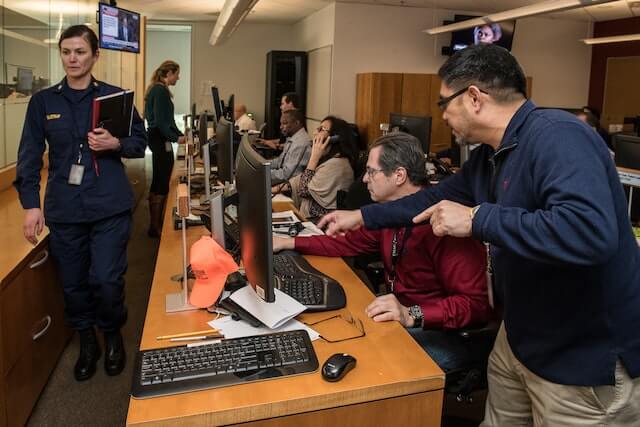If you have ever come across this question, ‘which of the following is an EOC function,’ then you might be here on this page to seek answers. When this question shows up, it is usually accompanied with the options:
- Collecting, analyzing, and sharing information
- Coordinating plans and determining resources needs
- Providing coordination and policy direction
- All of the above
Table of Contents
Which of the Following Is an EOC Function?
Interestingly, the answer to the question is ‘All of the above.’ That is to show us how versatile the emergency operation center (EOC) is. It plays a lot of importance roles in the NIMS system when looking to manage an emergency of disaster.
By understanding what an EOC is and how it operates, organizations can better prepare for, respond to, and manage an emergency situation. So, in this post, we will show you what an EOC is and the roles it plays in incident management.
What is an Emergency Operations Center?
An Emergency Operations Center (EOC) is a central location where emergency response personnel and other relevant personnel can coordinate and manage the response to an emergency or disaster. The EOC is typically activated during a large-scale or complex emergency that requires coordination among multiple agencies and organizations.
It is typically located within the vicinity of the incident or potential risk and can be either fixed or mobile. And it is usually staffed by personnel from various sectors who have been trained in emergency management.
The EOC is responsible for coordinating the response to an emergency, and for providing information and resources to emergency responders and the public. The EOC is also responsible for coordinating the recovery effort after an emergency.
Overview of the Emergency Operations Center
The EOC is an important tool in the response to an emergency. It provides a command center for responding to the incident, allowing personnel to quickly and effectively assess the situation and decide how best to respond.
At the EOC, personnel can access critical information such as maps, weather forecasts, evacuation plans, and communications systems. The EOC can also provide a platform for coordinating rescue efforts, distributing supplies, and providing medical assistance.
Benefits of an Emergency Operations Center
The primary benefit of an EOC is that it allows for quick and coordinated responses to emergency situations. By providing a central location for coordinating responses, the EOC allows personnel from multiple organizations and agencies to quickly collaborate and make decisions. This reduces confusion and helps ensure that appropriate resources are allocated quickly.
Another benefit is that it can help reduce the overall impact of an emergency situation. By coordinating responses and providing clear lines of communication, the EOC can help reduce the amount of damage caused by an emergency.
The EOC can also help improve the safety of responders and the general public. An EOC can help reduce the amount of confusion and chaos during an emergency. This can help ensure that responders are able to quickly and safely respond to an emergency situation.
What Are the Sections in an EOC?
The sections within an EOC are typically organized based on the specific functions that need to be performed during the emergency response. Common sections within an EOC include:
#1: Operations Section
The Operations Section is responsible for coordinating the overall response to the emergency. This includes determining the overall response strategy and tactics and identifying and acquiring the necessary resources, such as personnel, equipment, and supplies.
At the same time, the operation section ensures that all responding agencies and organizations are working towards the same goals.
#2: Planning Section
The Planning Section is responsible for collecting and analyzing information about the emergency, including the current situation, potential impacts, and resources that may be required.
The Planning Section also develops and maintains incident action plans, which outline the specific steps that will be taken to respond to the emergency.
#3: Logistics Section
The Logistics Section is responsible for acquiring and managing the resources (e.g., personnel, equipment, and supplies) needed to respond to the emergency. This includes identifying what resources are needed, obtaining them, and tracking their use during the response.
#4: Finance/Administration Section
The Finance/Administration Section is responsible for managing the financial and administrative aspects of the emergency response, including budgeting, tracking expenses, and processing invoices and payments.
#5: External Affairs/Information Section
The External Affairs/Information Section is responsible for managing the flow of information to and from the EOC, including communicating with the media and the public.
These are just a few examples of the types of sections that may be present in an EOC. The specific sections and their roles may vary depending on the needs of the emergency and the organizations involved in the response.
Types of Emergency Operations Centers

There are two types of EOCs: fixed and mobile. A fixed EOC is typically located in a permanent building such as a government facility or office building.
Whereas, a mobile EOC is typically located in a vehicle such as a van or trailer that can be quickly deployed to the incident site. Mobile EOCs provide the same capabilities as a fixed EOC but can be deployed quickly to respond to emergencies.
Fixed EOCs are usually larger and have more resources than mobile EOCs. They are typically used for long-term emergencies or disasters.
However, both types of EOCs have their advantages and disadvantages. It is up to the incident commander to decide which type of EOC is best for the situation.
Who Are the EOC Team Members
Still trying to help you see why the answer to the question, ‘which of the following is an EOC function’ is ‘All of the above.’ So, let’s take a quick look at some of the people that make up the EOC team.
The EOC team is typically composed of individuals from various agencies and organizations that are involved in the emergency response, including:
- Local, state, and federal government agencies: This may include agencies such as the police, fire department, public health department, and transportation agencies.
- Private-sector organizations: This may include utilities, transportation companies, and other organizations that may be needed to support the emergency response.
- Nongovernmental organizations: This may include organizations such as the Red Cross, which may provide assistance during emergencies.
- Other relevant personnel: This may include individuals with specialized expertise or skills that are needed to respond to the emergency, such as medical professionals, engineers, or technical experts.
The specific individuals and organizations that make up the EOC team will depend on the nature of the emergency and the resources that are needed to respond. The team may also include representatives from local, state, and federal government agencies, as well as private-sector and nongovernmental organizations.
The goal is to bring together a diverse group of individuals and organizations that can work together effectively to coordinate and manage the response to the emergency.
Final Note On Which of the Following Is an EOC Function
The Emergency Operations Center is an important tool that allows organizations to quickly and effectively respond to emergency situations. By understanding what an EOC is and how it operates, organizations can better prepare for, respond to, and manage an emergency situation.
So, the next time you come across the question, ‘which of the following is an EOC function,’ you will be able to tell what the correct answer is!
You may also like:
















